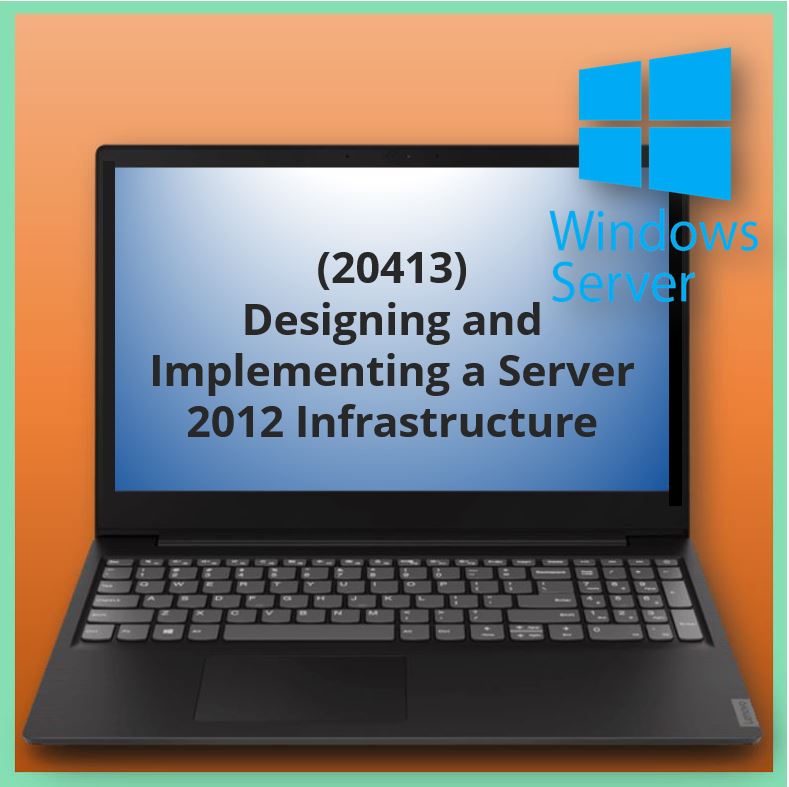Aangeboden leervormen
Designing and Implementing a Server 2012 Infrastructure (20413)
Course Description
This course provides you with the skills and knowledge needed to plan, design, and deploy a physical and logical Windows Server 2012 with Active Directory Domain Services (AD DS) infrastructure. The course also provides the skills to perform name resolution, application integration, optimization of automated remediation, and maintenance of network services.
At Course Completion
After completing this course, students will be able to:
· Plan server upgrade and migration.
· Plan and implement a server deployment infrastructure.
· Plan and deploy servers by using System Center 2012 R2 Virtual Machine Manager (VMM).
· Design and maintain an IP configuration and address management solution.
· Design and implement name resolution.
· Design and implement an AD DS forest and domain infrastructure.
· Design and implement an AD DS organizational unit (OU) infrastructure.
· Design and implement a Group Policy Object (GPO) strategy.
· Design and implement an AD DS physical topology.
· Plan and implement storage and file services.
· Design and implement network protection.
· Design and implement remote access services.
Voor wie
This course is intended for IT professionals who are responsible for planning, designing, and deploying a physical and a logical Windows Server 2012 enterprise AD DS infrastructure including the network services necessary. They have experience of previous Windows Server operating systems and possess Windows Server 2012 certification Microsoft Certified Solutions Associate (MCSA) or equivalent skills. The course is also intended for IT professionals who are looking to take the exam 70-413: Designing and Implementing a Server Infrastructure, as a stand-alone, or as part of the requirement for the Microsoft Certified Solutions Expert (MCSE): Server Infrastructure Certification.
Programma
Module 1: Planning Server Upgrade and Migration
This module explains how to plan a server upgrade and migration strategy.
Lessons
· Considerations for Upgrades and Migrations
· Creating a Server Upgrade and Migration Plan
· Planning for Virtualization
Lab : Planning a Server Upgrade and Migration
· Planning a Strategy for Server Upgrade and Migration
· Evaluating Candidates for Server Virtualization
After completing this module, students will be able to:
· Describe the factors to consider when performing a server upgrade and migration.
· Create a plan for a server upgrade and migration.
· Plan for server virtualization.
Module 2: Planning and Implementing a Server Deployment Infrastructure
This module explains how to design an automated server installation strategy and plan and implement a server deployment infrastructure.
Lessons
· Selecting an Appropriate Server Deployment Strategy
· Implementing an Automated Deployment Strategy
Lab : Planning and Implementing a Server Deployment Infrastructure
· Planning an Automated Server Installation and Deployment Strategy
· Preparing the Windows Server 2012 R2 Image
· Deploying Windows Server 2012 R2
After completing this module, students will be able to:
· Select an appropriate server deployment strategy.
· Implement an automated deployment strategy.
Module 3: Planning and Deploying Servers Using Virtual Machine Manager
This module explains how to plan and deploy a Virtual Machine Manager (VMM) infrastructure for deploying servers.
Lessons
· System Center 2012 R2 Virtual Machine Manager Overview
· Implementing a Virtual Machine Manager Library and Profiles
· Planning and Deploying Virtual Machine Manager Services
Lab : Planning and Deploying Virtual Machines by Using Virtual Machine Manager
· Planning Microsoft System Center 2012 R2 Virtual Machine Manager Components
· Planning Virtual Machine and Service Templates
· Implementing Virtual Machine Manager Components
After completing this module, students will be able to:
· Describe the core VMM architecture and components.
· Implement VMM libraries and profiles.
· Plan and deploy VMM services.
Module 4: Designing and Maintaining an IP Configuration and Address Management Solution.
This module explains how to design and maintain IP address management (IPAM) and a Dynamic Host Configuration Protocol (DHCP) solution.
Lessons
· Designing DHCP Servers
· Planning DHCP Scopes
· Designing an IPAM Provisioning Strategy
· Managing Servers and Address Spaces by Using IPAM
Lab : Designing and Maintaining an IP Configuration and IP Address Management Solution
· Planning DHCP to Support Your Proposal
· Planning an IPAM Deployment
· Implementing DHCP and IPAM
After completing this module, students will be able to:
· Design a DHCP server implementation.
· Plan DHCP scope configuration and options.
· Design an IPAM provisioning strategy.
· Manage servers and address spaces by using IPAM.
Module 5: Designing and Implementing Name Resolution
This module explains how to design a name resolution strategy.
Lessons
· Designing a DNS Server Implementation Strategy
· Designing the DNS Namespace
· Designing DNS Zones
· Designing DNS Zone Replication and Delegation
· Optimizing DNS Servers
· Designing DNS for High Availability and Security
Lab : Designing and Implementing Name Resolution
· Designing a Strategy for DNS Name Resolution
· Designing a Strategy for DNS Server Placement
· Designing DNS Zones and DNS Zone Replication
· Implementing DNS
After completing this module, students will be able to:
· Design a Domain Name System (DNS) server-implementation strategy.
· Design a DNS namespace.
· Design and implement a DNS zone strategy.
· Design and configure DNS zone replication and delegation.
· Optimize the DNS server configuration.
· Design DNS for high availability and security.
Module 6: Designing and Implementing an Active Directory Domain Services Forest and Domain Infrastructure
This module explains how to design and implement an AD DS forest and domain infrastructure.
Lessons
· Designing an Active Directory Forest
· Designing and Implementing Active Directory Forest Trusts
· Designing Active Directory Integration with Windows Azure Active Directory
· Designing and Implementing Active Directory Domains
· Designing DNS Namespaces in AD DS Environments
· Designing Active Directory Domain Trusts
Lab : Designing and Implementing an Active Directory Domain Services Forest Infrastructure
· Designing an Active Directory Forest Infrastructure
· Implementing Active Directory Forest Trusts
Lab : Designing and Implementing an Active Directory Domain Infrastructure
· Designing an Active Directory Domain Infrastructure
· Implementing an Active Directory Domain Infrastructure
After completing this module, students will be able to:
· Design an Active Directory forest.
· Design and implement Active Directory forest trusts.
· Design Active Directory integration with Windows Azure Active Directory.
· Design and implement Active Directory domains.
· Design DNS namespaces in an AD DS environment.
· Design and implement Active Directory domain trusts.
Module 7: Designing and Implementing an AD DS Organizational Unit Infrastructure
This module explains how to design and implement an OU infrastructure and an AD DS permissions model.
Lessons
· Planning the Active Directory Administrative Tasks Delegation Model
· Designing an OU Structure
· Designing and Implementing an AD DS Group Strategy
Lab : Designing and Implementing an Active Directory OU Infrastructure and Delegation Model
· Designing an Organizational Unit Infrastructure
· Implementing the OU Design
· Designing and Implementing an Active Directory Permissions Model
After completing this module, students will be able to:
· Plan an Active Directory administrative tasks delegation model.
· Design an OU structure.
· Design and implement an AD DS group strategy.
Module 8: Designing and Implementing a Group Policy Object Strategy
This module explains how to design and implement a Group Policy Object (GPO) strategy.
Lessons
· Collecting the Information Required for a GPO Design
· Designing and Implementing GPOs
· Designing GPO Processing
· Planning Group Policy Management
Lab : Designing and Implementing a Group Policy Object Strategy
· Designing a GPO Strategy
· Implementing the GPO Design
After completing this module, students will be able to:
· Collect and analyze the information required to facilitate a GPO design.
· Create a GPO design and implement it.
· Create a GPO processing design.
· Plan GPO management.
Module 9: Designing and Implementing an AD DS Physical Topology
This module explains how to design an AD DS sites topology and a domain controller placement strategy.
Lessons
· Designing and Implementing Active Directory Sites
· Designing Active Directory Replication
· Designing the Placement of Domain Controllers
· Virtualization Considerations for Domain Controllers
· Designing Highly Available Domain Controllers
Lab : Designing and Implementing an Active Directory Domain Services Physical Topology
· Designing Active Directory Sites and Replication
· Planning the Placement of Domain Controllers and Active Directory Replication
· Implementing Active Directory Sites and Domain Controllers
After completing this module, students will be able to:
· Design and implement Active Directory sites.
· Design and configure Active Directory replication.
· Design domain controller placement.
· Plan for virtualization of the domain controller role.
· Design domain controller deployments for high availability.
Module 10: Planning and Implementing Storage and File Services
This module explains how to plan and implement storage and file services.
Lessons
· Planning and Implementing iSCSI SANs
· Planning and Implementing Storage Spaces
· Optimizing File Services for Branch Offices
Lab : Planning and Implementing Storage
· Planning a Storage Solution
· Implementing iSCSI Storage
· Configuring a Redundant Storage Space
After completing this module, students will be able to:
· Plan and implement an Internet Small Computer System Interface (iSCSI) SAN.
· Plan and implement storage spaces.
· Optimize file services for branch offices.
Module 11: Designing and Implementing Network Protection
This module explains how to design and implement network protection.
Lessons
· Overview of Network Security Design
· Designing and Implementing a Windows Firewall Strategy
· Designing and Implementing a NAP Infrastructure
Lab : Designing and Implementing Network Protection
· Designing a Windows Firewall Solution
· Implementing a Windows Firewall Solution
· Designing a NAP Solution
· Implementing NAP with IPsec Enforcement
After completing this module, students will be able to:
· Describe the design process for network security.
· Design and implement a Windows Firewall strategy.
· Design and implement Network Access Protection (NAP).
Module 12: Designing and Implementing Remote Access Services
This module explains how to design and implement remote access services.
Lessons
· Planning and Implementing DirectAccess
· Planning and Implementing VPN
· Planning and Implementing Web Application Proxy
· Planning a Complex Remote Access Infrastructure
Lab : Designing and Implementing Network Access Services
· Designing a Remote Access Strategy
· Planning and Implementing a DirectAccess Solution
· Planning and Implementing a VPN Solution
· Implementing Web Application Proxy
After completing this module, students will be able to:
· Plan and implement DirectAccess.
· Plan and implement a virtual private network (VPN).
· Plan and implement a Web Application Proxy.
· Plan a complex remote access infrastructure.
Voorkennis
Candidates for this course have good Windows client and server operating system knowledge and basic AD DS and networking experience in an enterprise/small business (SMB) environment together with application configuration experience.
In addition to their professional experience, students who attend this training should already have the following technical knowledge:
• A good understanding of Transmission Control Protocol/Internet Protocol (TCP/IP) fundamentals and networking concepts.
• A good working knowledge of both Windows Server 2012 R2 and Active Directory Domain Services (AD DS). For example, domain user accounts, domain vs. local user accounts, user profiles, and group membership.
• A good understanding of both scripts and batch files.
• A solid understanding of security concepts, such as authentication and authorization.
• Familiarity with deployment, packaging, and imaging tools.
• Ability to work in a team/virtual team.
• Ability to produce good documentation and have the appropriate communication skills to create proposals and make budget recommendations.
• Knowledge equivalent to Windows 2012 R2 MCSA.
Students who attend this training can meet the prerequisites by attending the following courses, or obtaining equivalent knowledge and skills:
• 20410C: Installing and Configuring Windows Server 2012
• 20411C: Administering Windows Server 2012
• 20412C: Configuring Advanced Windows Server 2012 Services
OR
• 20417C: Upgrading Your Skills to MCSA Windows Server 2012
Examen
Microsoft examen 70-413 Designing and Implementing a Server 2012 Infrastructure
Duur training
Open Leercentrum: 5 dagen
E=Learning: 90 dagen










